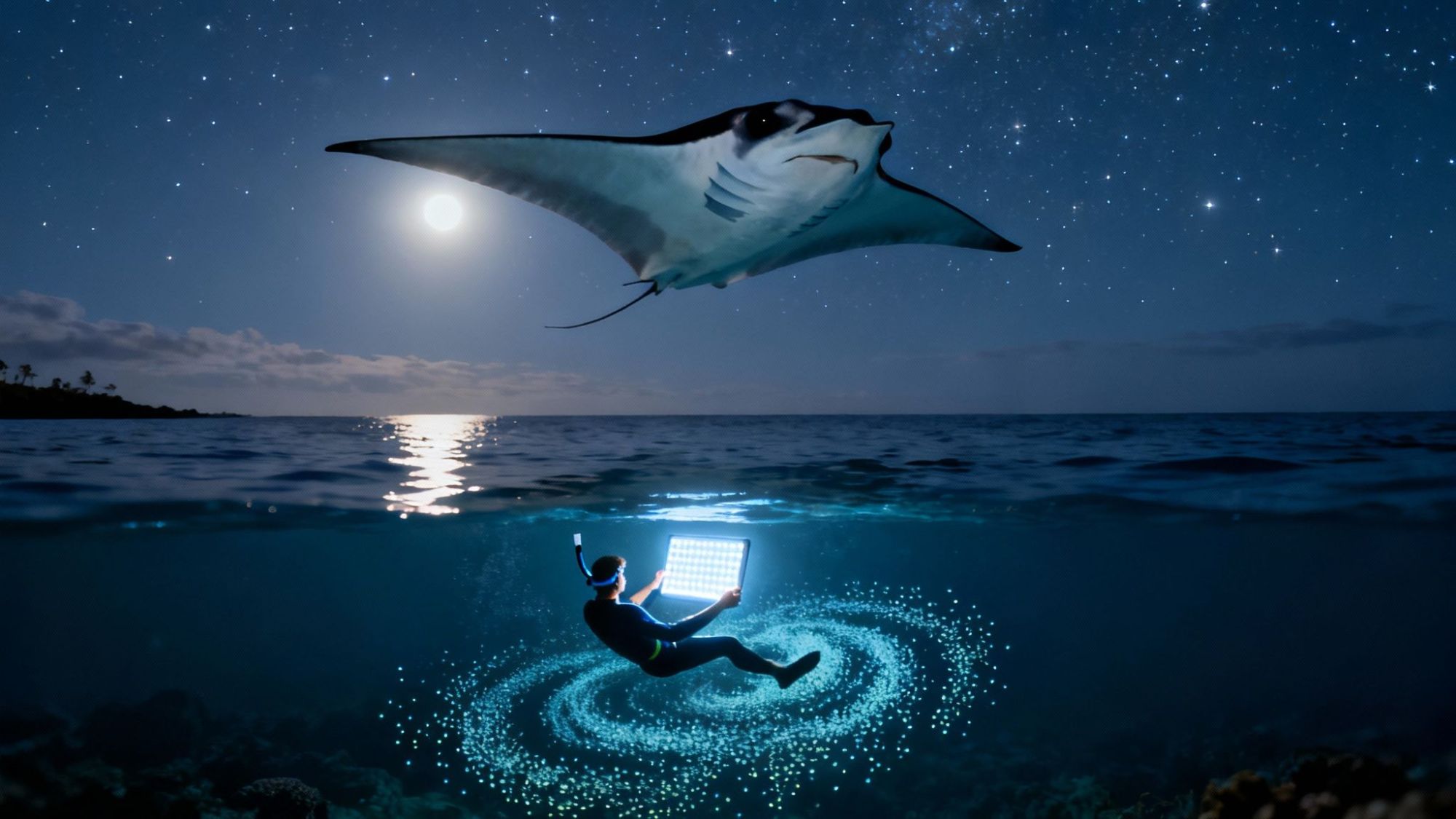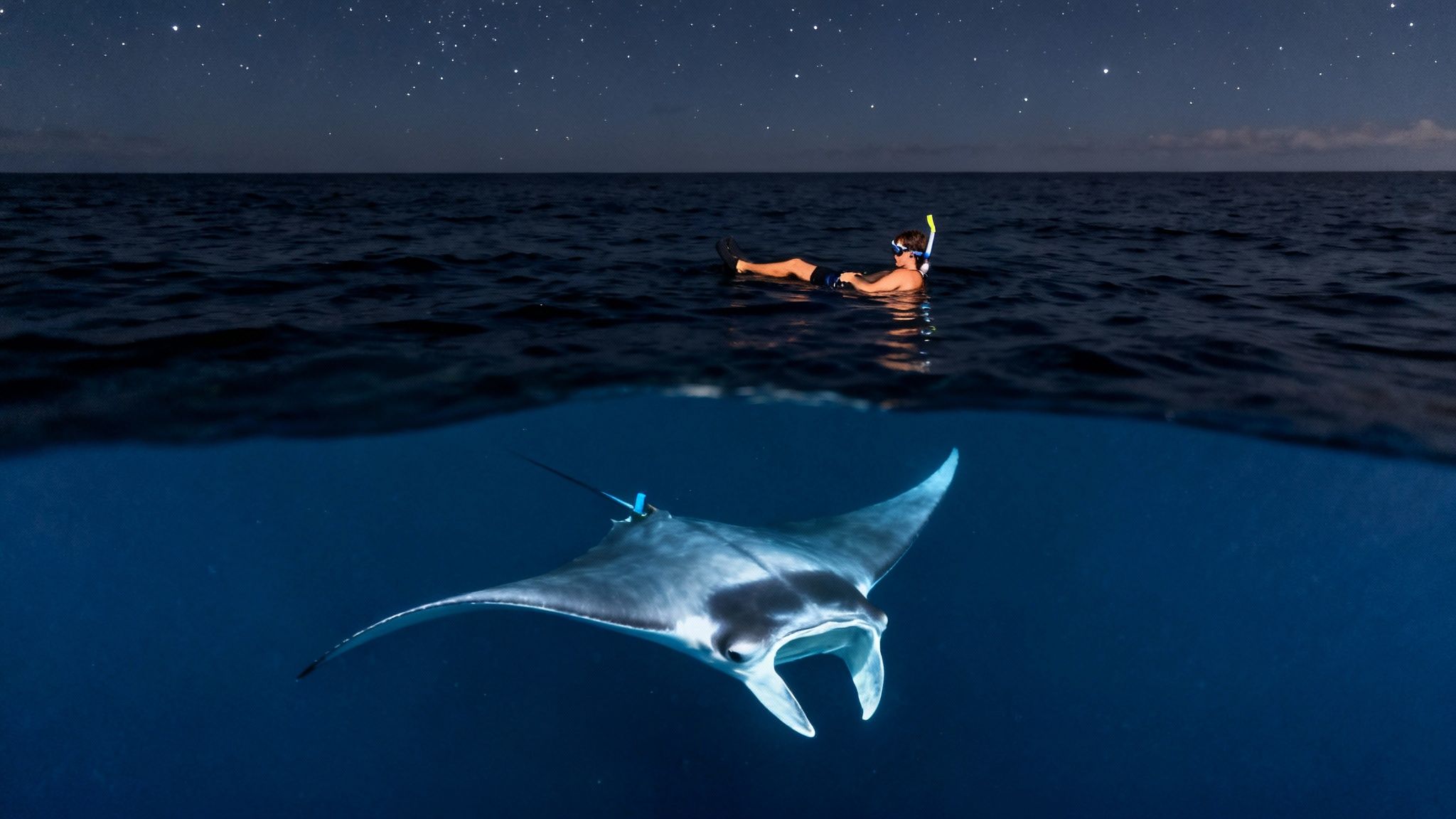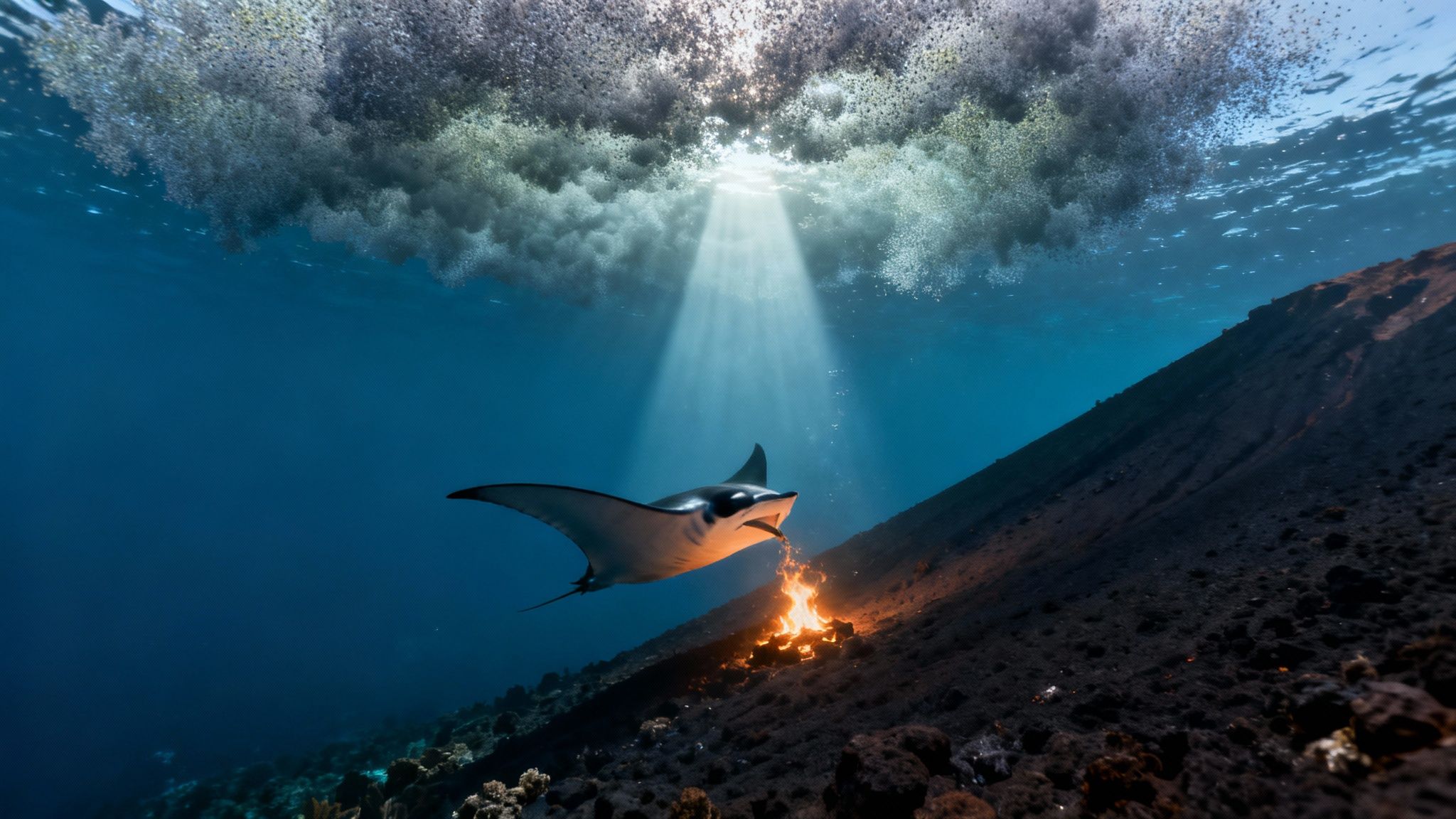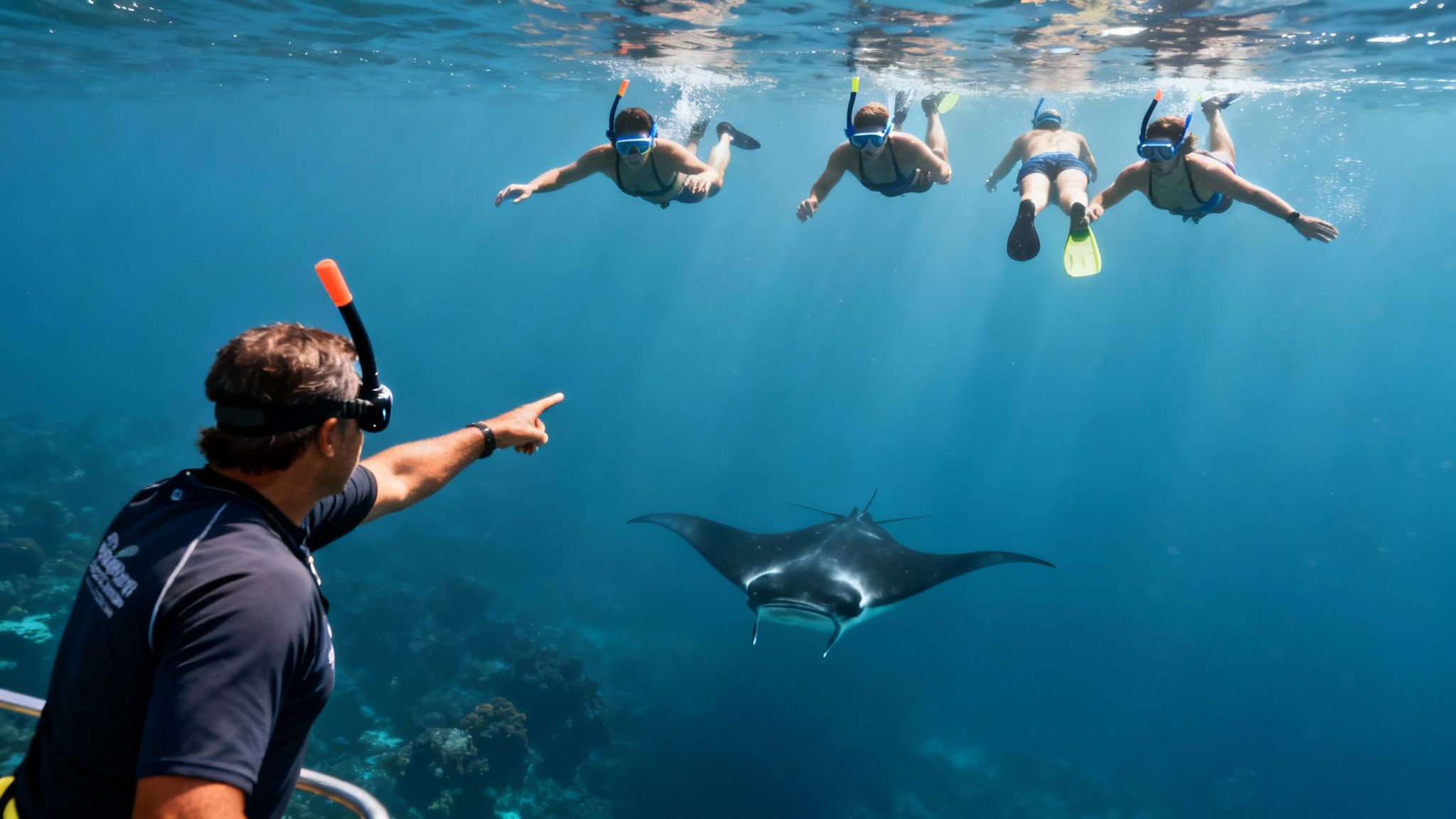Manta Ray Night Snorkel Kona: Your Ultimate Guide to an Unforgettable Ocean Adventure

Picture this: you're floating weightlessly in the calm, dark Pacific off the Kona coast. Below you, giant, graceful manta rays soar through the water like underwater angels. It's one of the most magical wildlife encounters on the planet, and this guide is here to walk you through everything you need to know to make it happen.
We'll cover why Kona is the world's best spot for this adventure and how to prepare for your trip, turning that bucket-list dream into an unforgettable reality.
Your Guide to an Unforgettable Manta Ray Encounter

The manta ray night snorkel in Kona isn't just another tour; it's like having a front-row seat to an incredible underwater ballet, performed by some of the ocean's most majestic animals. To make sure you're in the best hands for this once-in-a-lifetime experience, let's start with Kona Snorkel Trips, known for being Hawaii's top-rated and most-reviewed snorkel company. They've built their reputation on safe, respectful, and genuinely jaw-dropping marine adventures.
You don't have to take our word for it—the reviews above speak for themselves, showing the kind of amazing experiences they deliver night after night. For anyone ready to jump in, their premier trip is the Manta Ray Snorkel Kona tour, which really sets the gold standard for this unique activity.
Why Kona is a Global Manta Ray Hotspot
So, what is it about the Kona coast that makes it the perfect stage for this natural spectacle? It’s really a perfect storm of geography, biology, and a little bit of human help. The conditions are so consistently ideal that it's become one of the most reliable wildlife encounters you can find anywhere on Earth.
Kona is hands-down one of the best places in the world to see manta rays at night, mainly because of its huge and reliable population. We're talking about an estimated 130 resident mantas, with more than 120 of them cataloged and spotted regularly right here along the coast. This leads to incredibly high sighting success rates, usually somewhere between 80–90%. You can learn more about what makes the Kona experience so unique and why it's so different from anywhere else.
This special environment gives snorkelers a few key advantages for a successful manta ray night snorkel in Kona:
- A Resident Population: Unlike other spots where mantas are just passing through seasonally, Kona is home to a year-round crew. These mantas don't migrate far, so your chances of seeing them are fantastic no matter when you visit.
- Ideal Feeding Grounds: The underwater volcanic landscape creates natural funnels where plankton—the mantas' favorite food—gathers. This turns certain sites into a reliable manta buffet, night after night.
- Calm and Accessible Waters: The Big Island's leeward side is shielded from big ocean swells. This usually means calm, clear water, which is perfect for snorkelers of all experience levels.
When you're shopping around for a great tour operator, another exceptional alternative to check out is Manta Ray Night Snorkel Hawaii. Their local expertise is a big part of what makes the experiences here in Kona so top-notch.
Understanding Kona's Manta Ray Magic

So what makes the manta ray night snorkel in Kona an experience people rave about for years? It's not just random luck. It’s actually a brilliant mix of unique geology, marine biology, and a bit of human ingenuity that sets the stage for a spectacular show almost every night.
The magic really starts with the Big Island’s volcanic landscape. Ancient lava flows have created a very specific type of underwater terrain, one that’s absolutely perfect for plankton—the microscopic critters manta rays love to eat. The steep slopes and deep channels right off the Kona coast create a natural phenomenon called upwelling, which is like a giant, slow-motion elevator bringing nutrient-rich water from the deep ocean up to the surface. This process kicks off a plankton bloom, basically turning the coastline into a massive, all-you-can-eat manta buffet.
This constant food supply is the main reason Kona has such a large, resident population of reef mantas. Unlike other places where you might catch a glimpse of mantas just passing through, our mantas live here year-round. That's why the sighting success rates are so consistently high, often hitting over 90%.
The Underwater Campfire Effect
While the island’s geography provides the food, the real secret to the nightly show is a clever trick local guides have perfected over the years. We call it the "underwater campfire."
After we motor out to a specific feeding spot, we submerge powerful, eco-friendly lights into the ocean. Just like bugs to a porch light, plankton are drawn to the bright glow, gathering in a thick, shimmering cloud. To a hungry manta ray, this concentrated ball of food is a dinner bell they simply can't ignore.
They show up to glide effortlessly through the light beams, performing graceful barrel rolls as they filter-feed on the dense plankton cloud.
This simple yet genius setup turns a what-if encounter into a highly predictable, breathtaking performance. It allows us to watch their natural feeding behavior from just inches away, night after night.
Kona's Premier Manta Viewing Locations
This one-two punch of natural feeding grounds and the "underwater campfire" strategy has helped establish a few world-famous viewing sites. Two of the most reliable and well-known spots for the manta ray night snorkel in Kona are Manta Village and Manta Heaven.
- Manta Village: This is the original site, located just south of Kailua-Kona near the Sheraton Keauhou Bay Resort. It’s close to shore, usually has very calm water, and boasts one of the highest success rates for manta sightings anywhere.
- Manta Heaven: You'll find this spot, also known as Garden Eel Cove, north of Kona near the airport. It's famous for drawing in larger groups of mantas. On a great night, you could see a dozen or more rays dancing in the lights.
Both spots take full advantage of the unique underwater topography and have become reliable feeding stations where the local mantas know to show up when the lights come on. Knowing the science behind it all gives you a much deeper appreciation for the incredible spectacle unfolding right in front of your mask.
If you're as hooked on these animals as we are, check out these fun facts about manta rays. It transforms a beautiful swim into a real connection with one of the ocean's most gentle and intelligent giants.
What to Expect During Your Night Snorkel

So, you're thinking about the manta ray night snorkel. Good. It’s an experience that’s hard to put into words, a little like stepping into a different dimension right off the Kona coast. Knowing the play-by-play, from the moment you meet the crew to that final climb back onto the boat, helps calm any nerves and lets you just soak it all in.
Your adventure kicks off in the late afternoon with a check-in at the harbor. This is where you’ll meet the crew—your guides for the night. After a warm aloha, you'll get settled on the boat and head out along the coast. The timing is perfect; you get to watch the Hawaiian sun dip below the horizon, lighting up the sky in incredible colors.
The Journey to the Manta Site
The boat ride itself is part of the magic. You’re cruising along the volcanic coastline, watching a world-class sunset, and the anticipation for what's coming just keeps building. During this ride, your guides will run through a crucial safety briefing.
Listen up here, because this is important. They’ll cover how to use your gear and go over the golden rule of manta encounters: look, but don't touch. They'll explain that manta rays have a protective mucus layer, and our touch can strip it away, leaving them vulnerable to infections. Keeping you and the mantas safe is their top priority.
Once you motor up to one of the viewing sites—usually "Manta Village" or "Manta Heaven"—the crew gets the main attraction ready. They'll deploy a custom-built, floating light board that looks like a big raft with powerful lights shining down into the water. This is the dinner bell. The light creates an underwater campfire effect, attracting massive clouds of plankton. The whole reason the mantas show up is because of these lights and the buffet they create, which really shows you the crucial role of live plankton in this unique ecosystem.
Entering the Water for the Main Event
With the light board glowing, it's time to get in. You'll slip into the warm, dark Pacific, kitted out in a wetsuit that keeps you perfectly warm and buoyant. From there, it's a short swim over to the light board where you'll find a spot and grab onto one of the handles.
Just floating there, looking down into the illuminated water, is surreal. The beams of light cut through the darkness, and you can see a blizzard of tiny plankton swirling around. And then you wait. The anticipation is thick as you float under the stars, with just the gentle sound of the water around you.
Then, out of the deep blue, a giant shadow appears. The first manta ray has arrived.
It’s a moment that just takes your breath away. These gentle giants, with wingspans that can stretch over 10 feet, glide effortlessly into the light. They perform this incredible, looping underwater ballet called a "barrel roll," swimming upside down with their huge mouths open to filter-feed on the plankton.
They soar inches—literally inches—below you. You're so close you can see the unique spot patterns on their undersides and watch their gills gently ripple. This isn’t like watching a nature documentary; you are in the documentary. It's quiet, awe-inspiring, and honestly, pretty emotional. You'll have about 45 minutes in the water, totally mesmerized by this silent, underwater dance. To capture these memories, you'll want to check out our tips on how to take underwater pictures.
Planning Your Manta Ray Adventure
Timing is everything when it comes to planning the perfect manta ray night snorkel in Kona. Sure, you can see these gentle giants year-round, but a little inside knowledge can turn a great trip into a legendary one. Getting the season, tour time, and even the moon phase just right will help you lock in an unforgettable night.
Think of it like this: Kona's weather is beautiful all year, but the ocean has its own moods. Picking the right time is all about finding that sweet spot for calm, clear water.
Finding the Sweet Spot in the Calendar
The absolute best time to visit is during the late spring through early fall, roughly from April to October. During these months, the ocean is typically flatter than a pancake, and the plankton—the mantas' favorite meal—is in full bloom.
This magical combination leads to an incredible 80-90% success rate for sightings. The manta population is stable, and their feeding habits are super predictable. If you want to dive deeper into the seasonal nitty-gritty, you can learn more about the best time to see manta rays in Kona.
Now, don't write off the winter months. A trip from November to March can still be amazing. The catch? You might get some larger ocean swells, which can mean a bumpier boat ride or, in rare cases, a cancelled tour. The upside is that you'll be sharing the water with fewer people, which can make for a more personal experience.
Sunset vs. Twilight Tours
Most operators give you two choices: a "sunset" tour or a later "twilight" tour. Both are fantastic, but they offer a slightly different vibe.
- Sunset Tour: This is the crowd favorite, and for good reason. You get a boat ride with a front-row seat to a jaw-dropping Hawaiian sunset. By the time you hop in the water, it's getting dark, and the mantas are just showing up for dinner.
- Twilight Tour: This one heads out after the sun has already dipped below the horizon. The big advantage here is that the "underwater campfire" of lights has been glowing for a while, which can pull in a bigger cloud of plankton and, hopefully, more mantas.
Leveraging the Moon and Tides
Want to really dial in your plans? Pay attention to the moon. It sounds a little mystical, but it can make a real difference.
The darkest nights, especially around a new moon, are prime time. With less moonlight competing, the tour operator's lights become an even stronger magnet for plankton. The whole underwater stage is set for a more intense and focused feeding frenzy.
It's a simple little detail that can seriously amplify the action.
To pull this all together, here’s a quick guide to help you plan the ultimate manta ray night snorkel in Kona.
Manta Ray Snorkel Planning Guide
| Factor | Optimal Choice | Reason |
|---|---|---|
| Best Months | April – October | Calmer ocean conditions and more abundant plankton. |
| Ocean Conditions | Calm, low swell | Provides a more comfortable snorkeling experience and better visibility. |
| Moon Phase | New Moon (Darker Sky) | Enhances the effectiveness of the tour lights in attracting plankton. |
| Tour Time | Sunset / Twilight | Offers beautiful views and aligns with manta feeding schedules. |
Following these simple tips can help ensure your time in the water with these majestic creatures is everything you hoped it would be.
Safety and Respectful Marine Interaction

When you're out on a manta ray night snorkel in Kona, two things matter above all else: your safety and the well-being of these incredible animals. The whole experience hinges on one simple, golden rule: be a passive observer. Think of yourself as a guest invited into their world for a brief, magical visit.
The most important part of this is a strict no-touching policy. It's not just a guideline; it's essential for their health. Manta rays are coated in a thin layer of protective mucus, which is their first line of defense against nasty bacteria and infections. Even a gentle touch can wipe this coating off, leaving them exposed and vulnerable.
So, the rule is simple: never touch, chase, or swim in front of the mantas. Just float, watch, and let them do their thing. This allows them to feed naturally and ensures the encounter is safe and amazing for everyone involved—mantas included.
The Role of Your Guide and Equipment
Listen up when your guides are talking! Their instructions are your ticket to a smooth and safe adventure. Before you even dip a toe in the water, the crew will give a full briefing on all the safety rules and how to interact respectfully with the mantas. These folks are experts on manta behavior and Kona's ocean conditions; their main job is keeping you safe.
That light board you'll be holding onto is a pretty clever piece of gear. It does more than just attract plankton for the mantas; it's a huge part of the safety plan.
- Keeps the Group Together: The board serves as a home base, ensuring everyone stays in one spot and no one drifts off in the dark.
- Makes Floating Easy: It’s super buoyant, so you can just relax and float without kicking or treading water. This lets you save your energy and put all your focus on the show below.
- Provides a Stable Platform: Holding on gives you a ton of stability, which makes this experience accessible even if you're not the world's strongest swimmer.
Using your gear correctly—mask, snorkel, and wetsuit—is just as important. The wetsuit isn't just for warmth; it adds extra buoyancy, making it even easier to float. A well-sealed mask means a crystal-clear view of the underwater ballet. For more tips on staying safe in the ocean, check out our guide on snorkeling safety tips.
Supporting a Sustainable Future
Taking part in a manta ray night snorkel in Kona is more than just an unforgettable vacation highlight. When you choose a reputable, responsible tour company, you're throwing your support behind a sustainable tourism model that helps protect this amazing marine ecosystem.
Good operators stick to strict guidelines designed to keep the impact on the mantas and their home to an absolute minimum. This includes things like:
- Limiting how many snorkelers are in the water at once.
- Using special eco-friendly lights that don't disturb marine life.
- Teaching every guest about conservation and respectful behavior.
This commitment is what keeps the manta encounters in Kona a positive, non-invasive experience for the animals. Your choice has a real impact, helping to ensure the long-term health of the local manta population for future generations to enjoy.
While marine safety is front and center on this tour, being prepared is smart for any kind of travel. Thinking ahead about things like essential first aid kit preparedness can make any trip smoother. This kind of thoughtful approach to safety, both in and out of the water, is what makes for a truly responsible and unforgettable adventure.
How to Book the Right Manta Ray Tour
Okay, so you're sold on the idea of swimming with these gentle giants. The next step? Picking a tour. With a bunch of companies offering the manta ray night snorkel in Kona, it can feel a little dizzying trying to choose the right one.
Let's be real, it's not just about seeing the mantas; it's about how you see them. The goal is to find an operator that matches what you're looking for in terms of comfort, safety, and creating a genuine connection with the experience.
Key Factors to Consider Before Booking
When you start comparing tours, try to look beyond just the price tag. A little homework upfront can be the difference between a good night and a truly unforgettable one.
- Boat Size and Group Capacity: This is a big one. Smaller groups almost always mean a more personal and less crowded experience. With fewer people in the water, you'll have more space to float and a much better, unobstructed view of the manta ballet happening below you.
- What’s Included: Dig into the details. Are high-quality wetsuits, snorkel gear, and maybe some snacks and drinks part of the package? A cup of hot cocoa and a few snacks after your swim can feel like pure luxury on the cool ride back to the harbor.
- Guide Experience: This can make or break your trip. Guides who are genuinely passionate about marine conservation don't just point out the mantas; they share fascinating stories about their behavior and make sure the whole encounter is safe and respectful for the animals.
A crucial piece of advice: book your tour well in advance. This is especially true if you're traveling during the busy season, which generally runs from April to October. These incredible tours fill up fast, and you don't want to be left on the dock. Nailing down your spot early ensures you get to go with one of the top-rated companies.
Choosing a tour is really about investing in a memory. Prioritizing smaller group sizes and experienced, passionate guides often leads to a much more profound and memorable connection with these gentle giants.
For a fantastic option with a solid reputation for creating great experiences, check out Manta Ray Night Snorkel Hawaii when you're looking at tours. It always pays to explore your options to find the perfect fit for your trip.
At the end of the day, the "best" tour is the one that lines up with your personal style and comfort level, setting the stage for an evening you'll be talking about for years. You can learn more and book another top-tier adventure on this Manta Ray Snorkel Kona tour page.
Your Manta Ray Snorkel Questions Answered
It's totally normal to have a few questions buzzing around your head before you jump in the water for the first time, especially at night. Getting these sorted out beforehand helps you relax and really soak in the magic of the whole experience. Let's tackle some of the most common questions we hear from our guests.
Do I Need to Be an Expert Swimmer?
Not at all. This is one of the biggest misconceptions, and the great news is that this adventure is incredibly friendly for beginners. You definitely don’t need to be a competitive swimmer to have a fantastic time.
Tour operators, including us, provide all the floatation you need. You'll get a snug wetsuit that makes you naturally buoyant, and most importantly, you'll be holding onto a big, stable light board the entire time. There's hardly any "swimming" involved—it's more like floating and watching the incredible show happening right below you. If you're comfortable in the water and can breathe through a snorkel, you're good to go.
Is This Experience Safe?
Absolutely. When you go with a professional, reputable company, the manta ray night snorkel is considered very safe. There's a reason these beautiful creatures are called "gentle giants"—they are completely harmless to people.
Manta rays don't have teeth, stingers, or barbs like their stingray cousins. They are filter feeders, meaning their diet is made up of tiny plankton, so they have zero interest in snorkelers. Tour safety protocols are strict and simple: listen to your guide, stay with the group, and just be a passive observer of the marine life. Certified guides and thorough safety briefings are standard practice for any quality operator.
What Should I Bring on the Tour?
We provide all the main gear you'll need—wetsuit, mask, snorkel, and fins. That said, a few personal items can make your trip a whole lot more comfortable.
- A Towel: Essential for drying off once you're back on the boat.
- Warm Clothes: It can get surprisingly chilly on the boat ride back. A warm jacket or a change of dry clothes makes a huge difference.
- Motion Sickness Medication: If you're even a little prone to seasickness, it's a good idea to take something before the boat leaves the harbor.
- Waterproof Camera: Trust us, you'll want to capture this. The photo ops are out of this world!
Are Manta Ray Sightings Guaranteed?
While nothing in nature is ever 100% guaranteed, the Kona manta ray night snorkel has one of the most reliable wildlife sighting rates on the planet, often topping 90%. The specific feeding sites and the "underwater campfire" of lights make sightings remarkably consistent.
To give you complete peace of mind, most top-tier tour companies offer a "manta guarantee." What this usually means is if you're in that unlucky small percentage and don't see any mantas, you can come back and try again another night for free (based on availability, of course).
Ready to witness this incredible underwater ballet for yourself? With Kona Snorkel Trips, you're choosing Hawaii's highest-rated and most-reviewed snorkel company for an unforgettable and safe adventure.
